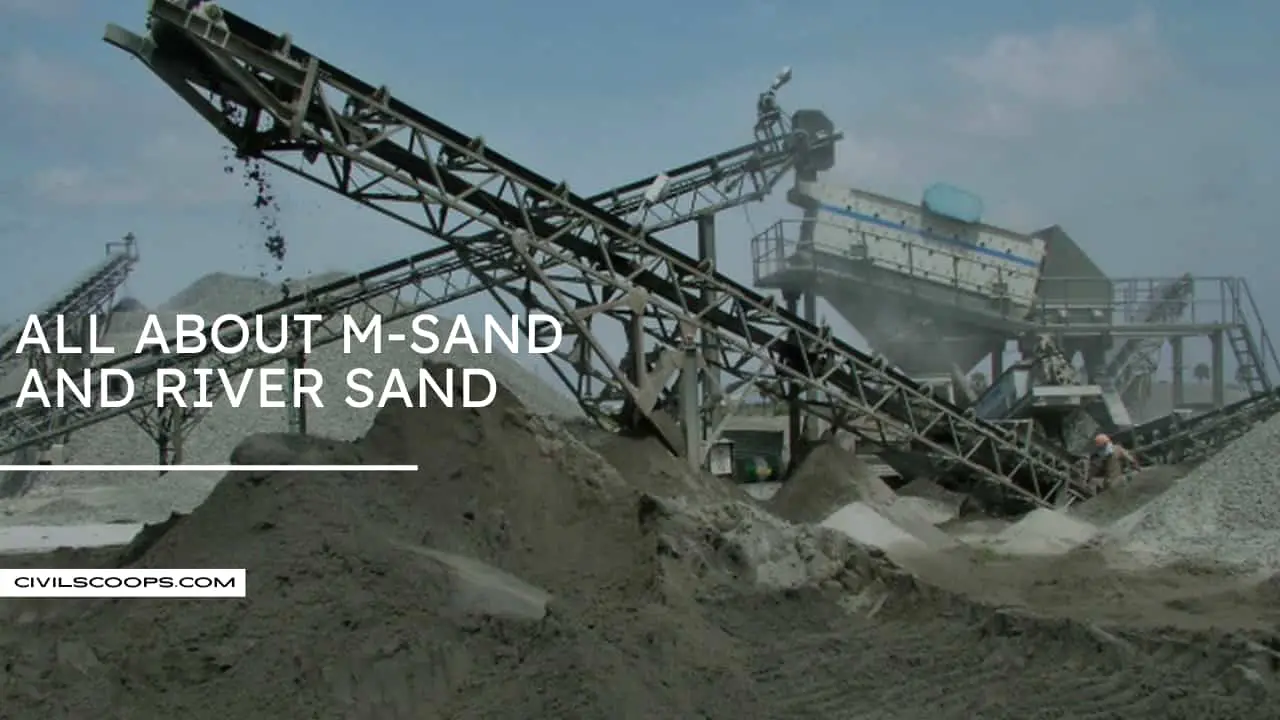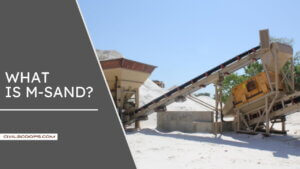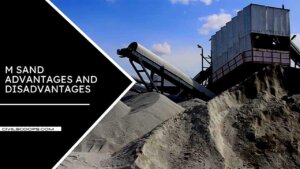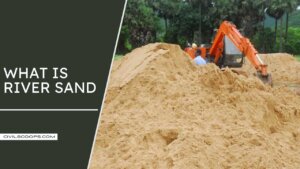All About M-Sand And River Sand | What is M-Sand | M-Sand Bonding Strength | What is River Sand |

Table of Contents
What is M-Sand?

M- Sand full name is Manufacturer Sand. M Sand is nothing but artificial sand made from crushing of rock or granite for construction purposes in cement or concrete. M sand differs from natural river sand in its physical and mineralogical properties.
Sand is one of the important ingredients at making concrete mortar & plaster, etc. Earth scientists and organizations are now promoting the use of M-Sand(Manufactured Sand).
It is produced by crushing of quarry and rocks stones to desired sizes. To derive the required sizes, these hard rock deposits are crushed, and this material is segregated in different fractions to suit different construction sites.
The chemical characteristics and strength of M-Sand(Manufactured Sand) are similar to river sand.
M-Sand(Manufactured Sand) as a silt content of around 0.2 percent and water absorption of 1.6 percent, as compared to 0.45 percent and 1.15 percent respectively in river sand
This sand alternative of river sand/natural sand. M-sand(Manufactured Sand) cheaper sand as per river sand.
M-Sand Bonding Strength.
M-Sand is manufactured in a three-stage process:
Crushing:
- Quarry and Rocks stones are crushed at jaw crushers, cone crushers, and vertical shaft impact crushers, respectively leading into the formation of angular and cubical fine aggregate particles.
Screening:
- Screening ensures this material is properly graded that’s similar to river sand.
Washing:
- Washing removes all the micro-fine particles. Also, fine aggregates for concrete and plaster sand are also formed.
M Sand Advantages and Disadvantages

Advantages of M-sand
- The major advantage of manufactured sand is that it is highly cohesive and compressive in strength.
- It has lesser impurities, which help in producing better quality concrete.
- Moreover, the controlled gradation of Zone-II is possible, suitable for concrete.
- In some case studies, it was found that concrete produced by using manufactured sand obtained 6-9 %(percent) higher compressive strength and 12-15 %(percent) higher flexural strength compared to river sand of the same grade.
- A nearly 30 %(percent) increase in masonry strength is obtained with the use of manufactured sand.
- It requires a lower water-cement ratio if the mortar is mixed with manufactured sand, which also results in better characteristics in the hardened state.
- Manufacturing sand also eliminates the environmental impact that occurred due to the lifting of natural sand from the river bed.
Disadvantages of M-sand /(M Sand Disadvantages)
- Improper crushing of manufacturing sand may lead to angular and flaky particles that are not suitable for concrete production, both technically and economically.
- Also, an adequate set up of crusher may not be available in some parts of the county like West Bengal, as it costs higher than river sand.
- For high-grade pumpable concrete in high-rise buildings, the requirement of cement is higher than the river sand, which may not be cost-effective.
What is River Sand?

It is naturally available and extracted from the river beds or riverbank. Naturally, river sand easy available in the market, this sand larges use in construction.
The shape of Crushed sand is angular and cubical and has a rough texture and hence, better for concrete. River sand use of the construction industry is growing with major trust in infrastructure, and the demand for sand is also increasing.
This overuse of river sand for construction has many social consequences and undesirable environmental. This Sand is used as fine aggregate in mortar concreter, and Natural river sand is this most preferred choice as a fine aggregate material.
This Sand is becoming a scarce commodity now. This sand is far superior for construction purposes than any other sand used in construction.
Difference Between M Sand and River Sand

[su_table responsive=”yes” alternate=”no”]
| Sr.No. | M-Sand | River Sand |
| 1 | M-Sand manufactured in a factory | This naturally available on river banks |
| 2 | The source of Crushed sand is a quarry. It is manufactured by quarry stones, Crushing rocks, or larger aggregate pieces into sand size particles in a factory or quarry. | This is naturally available and extracted from the riverbanks or river beds. |
| 3 | The shape of Crushed sand is angular and cubical and has a rough texture and hence, better for concrete. | The shape of natural sand is rounded and has a smooth surface. |
| 4 | No moisture content. | Moisture is generally present between the particles. Hence, it affects the assumptions of concrete mix design and quality of concrete. |
| 5 | This sand highly recommended for RCC purposes and brick/block works. | River sand is recommended for RCC, plastering and brick/blockwork. |
| 6 | Particle passing 75 microns: Up to 15% (IS: 383-1970) | Particle passing 75 microns: Up to 3% (IS: 383-1970) |
| 7 | M-sand specific gravity is approximate 2.73 (Depend on parent rock.) | River sand specific gravity is approximate 2.65 (Depend on rocks in the catchment area.) |
| 8 | M-sand dry density of 1.75 kg/m3 | Naturally Sand dry density of 1.44 kg/m3 |
| 9 | M-sand is manufactured to conform to zone II. | this sand mostly conforms to zone II and zone III |
| 10 | This is less adulteration. | this is a high probability of adulteration because of acute shortage. Natural sand adulteration with saline sea sand is common in coastal areas. |
| 11 | M-sand less damage to the environment as compared to natural sand. | This river sand is harmful to the environment. It reduces the groundwater level and rivers water gets dried up. |
| 12 | M sand price Near About Rs 900/Ton | River sand price Near About Rs 480/Ton |
[/su_table]
Comparison of M-Sand and River Sand
[su_table responsive=”yes” alternate=”no”]
| IS Sieve | M-Sand % Age Passing | River Sand % Age Passing | % Age passing for single Normal Sand 115 383 – 19701 Zone II | IS Sieve | M-Sand % Age Passing | River Sand % Age Passing | % Age passing for single Normal Sand 115 383 – 19702 Zone II | IS Sieve | IS Sieve | M-Sand % Age Passing |
| 4.75 mm | 99.75 | 99.25 | 100 to 90 | 4.76 mm | 98.75 | 98.25 | 100 to 91 | 4.77 mm | 4.76 mm | 98.75 |
| 2.36 mm | 78.25 | 93.5 | 100 to 75 | 2.37 mm | 108.75 | 124 | 100 to 76 | 2.38 mm | 2.37 mm | 108.75 |
| 1.18 mm | 52.00 | 48.00 | 90 to 55 | 1.19 mm | 44.00 | 40 | 90 to 56 | 1.20 mm | 1.19 mm | 44 |
| 600 microns | 38.00 | 21.00 | 59 to 35 | 601 microns | 4.00 | -13 | 59 to 36 | 602 microns | 601 microns | 4 |
| 300 microns | 21.00 | 4.00 | 30 to 08 | 301 microns | -13.00 | -30 | 30 to 09 | 302 microns | 301 microns | -13 |
| 150 microns | 5.00 | 0.05 | 10 to 0 | 151 microns | -4.9 | -9.85 | 10 to 1 | 152 microns | 151 microns | -4.9 |
[/su_table]
Use of sand
- In the real world, there are a lot of situations where we can find the use of sand. The rearing sand has common uses.
- We can use sand to hold your painting or wall art by combining 2 cups of paint with a cup of sand.
- People make sandpaper by polishing the sand to a paper.
- When hoisting the metal, we can mix sand with clay dams for the frameworks used in casting.
- Industrial sand is used to make glass, as foundry sand and abrasive sand.
- Adds texture and aesthetic appeal to space.
- Sand is mostly pure, immediately available, and economically intelligent.
- We can build children’s sandpits to keep play areas safe. It is also very cheap.
- We use sand in aquariums, craft artificial fringing reefs, and man-made beaches
- Sandy soil is ideal for growing crops, fruits, and vegetables such as watermelon, peaches, peanuts, etc.
- Sand can light a passageway by filling mason jars with sand and tea lights, which is another inexpensive way to make a walkway
shine. - We can place a small screw of sand near a charcoal grill for flare-ups.
- Sand can be used for cleaning a narrow neck by adding a little sand and warm soapy water to the container.
- We can stabilize an item that needs to be repaired using sand. Burying broken pieces under sand grains helps keep the elements together while gluing.
- Sand helps improve resistance (and thus traffic safety) in icy or icy conditions.
[su_box title=”FAQ” style=”default” box_color=”#333333″ title_color=”#FFFFFF” radius=”3″ class=”” id=””]
Manufacture of Sand
Manufactured sand is produced from hard granite stone by crushing. The crushed sand is of cubical shape with grounded edges, washed and graded to as a construction material. The size of manufactured sand (M-Sand) is less than 4.75mm.
[/su_box]
[su_note note_color=”#F2F2F2 ” text_color=”#333333″ radius=”3″ class=”” id=””]
Like this post? Share it with your friends!
Suggested Read –
- What is MDF | Advantage s| Disadvantages| Application | Properties | Thickness
- All About of Fence | What Is Fence | Different Types of Fences | Advantages of Fence
- What Is Formwork | Types of Formwork| Formwork in Construction| Formwork Materials
- All About of Mortar | What Is Mortar | How to Make Mortar | How to Mix Mortar | Mortar in Construction | Functions of mortar
- Types of Crawl Space Insulation | Fiber glass Batt Insulation | Closed Cell Spray Foam Insulation | Open-Cell Foam Spray Insulation | Rigid Foam Insulation and Use|
[/su_note]
Originally posted 2022-06-16 17:22:47.
